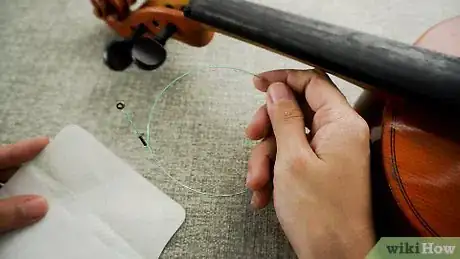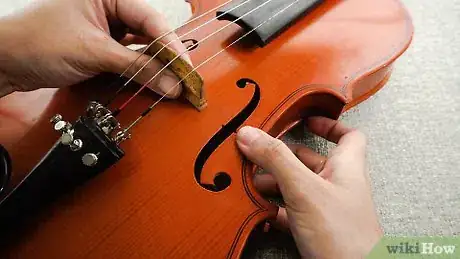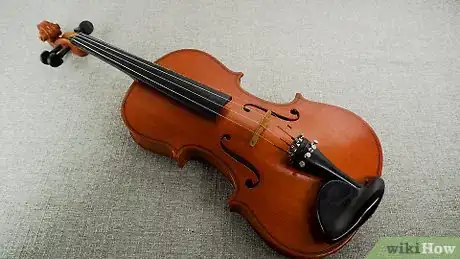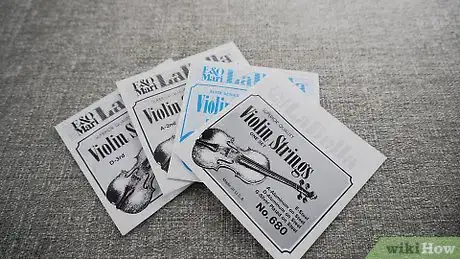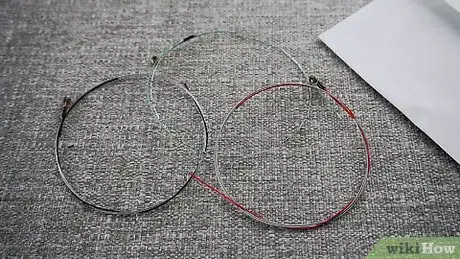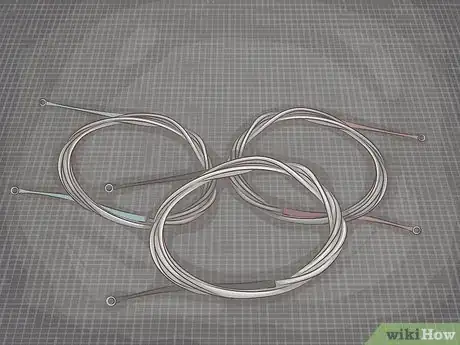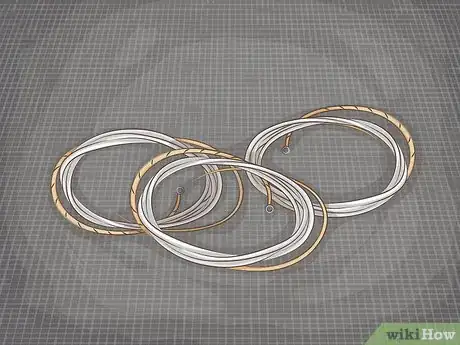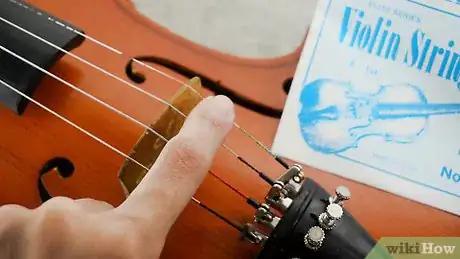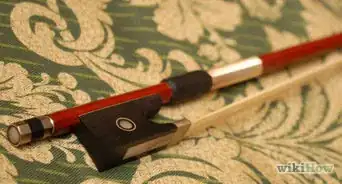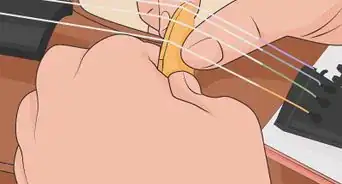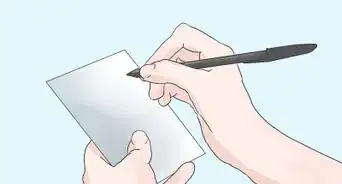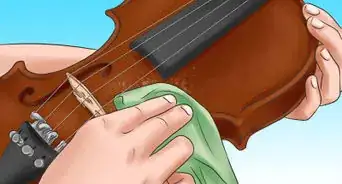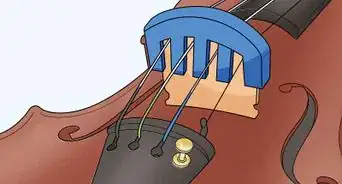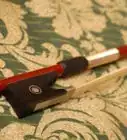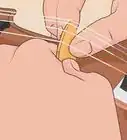This article was co-authored by Dalia Miguel. Dalia Miguel is a violinist and violin instructor based in the San Francisco Bay Area. She is studying Music Education and Violin Performance at San Jose State University and has been playing violin for over 15 years. Dalia teaches students of all ages and performs with a variety of symphonies and orchestras in the Bay Area.
There are 9 references cited in this article, which can be found at the bottom of the page.
wikiHow marks an article as reader-approved once it receives enough positive feedback. In this case, 89% of readers who voted found the article helpful, earning it our reader-approved status.
This article has been viewed 120,660 times.
Learning to change your own violin strings will save you from making expensive trips to the shop, letting you keep playing and practicing. It's a good way to get more familiar with the action of your instrument as well, learning to see how it responds and settles in to a fresh set of strings. You can change strings, completely re-string your violin, and select the appropriate strings for the job. See Step 1 to learn to get a new set on your instrument.
Steps
Changing a String
-
1Remove each string and replace it individually. To keep the violin's bridge adjusted properly and to keep the tension from slackening too much, it's important to change each string individually, rather than taking all the strings off at once and replacing them, as is common on guitars and some other stringed instruments. If you've broken a string, put a new one on before removing the others. To remove old strings:[1]
- Twist the large tuning pegs toward you, so the string becomes loose.
- If you have fine tuners, remove the small metal ball attached to the strings from the tuners. If not, pull the string in the tailpiece toward you and pull up to release the string.
- Continue twisting the large tuners until the string is completely loose, and remove it from the tuning peg.
EXPERT TIPDalia Miguel is a violinist and violin instructor based in the San Francisco Bay Area. She is studying Music Education and Violin Performance at San Jose State University and has been playing violin for over 15 years. Dalia teaches students of all ages and performs with a variety of symphonies and orchestras in the Bay Area.Experienced Violin Instructor
 Dalia Miguel
Dalia Miguel
Experienced Violin InstructorExpect to change your strings often. Dalia Miguel, who teaches violin, says: "Depending on what kind of strings you play, how long you play, and how much you practice, you'll probably need to replace your strings about every 6 months. Strings can go anywhere from $40 to $150."
-
2Orient the new string properly. Remove the appropriate string from the package and find the tip of the string, which should be inserted into the tuning peg, and the bottom of the string, which should anchor the string in the fine tuner.[2]
- The top will typically be colored on the end to distinguish it from the other strings, and the bottom should have a small metal ball on the end to seat it in the fine tuner. The color depends upon the particular brand of strings you purchase.
Advertisement -
3Insert the string through the tuning peg. Holding the violin with the chin-rest facing you, find the correct tuning peg to orient yourself and locate the tiny hole in it. This should be inside the scroll. Insert the top of the string through the hole, far enough that about half an inch hangs out on the other side.[3]
- On almost every violin, the tuning pegs should be oriented in the same way. Make sure you insert the string into the correct peg:
- G string on the bottom left
- D string on the top left
- A string on the top right
- E string on the bottom right
- On almost every violin, the tuning pegs should be oriented in the same way. Make sure you insert the string into the correct peg:
-
4Seat the string at the base. If you have fine tuners, place the small metal ball in the appropriate slot. It sometimes has a tendency to pop out while you're tuning, so check with your thumb regularly while you're tightening the string to make sure the base is still seated in the fine-tuner snugly.[4]
-
5Start tightening the string by turning the peg. Turn the large tuner away from you, so the string wraps itself around the peg, tightening and taking up some of the slack. It can be kind of a balancing act, because you want to make sure the base of the string stays seated (pop it back in if it pops out) and make sure that the string wraps around the top peg as straight as possible, which will make it easier to tune.
- To keep the string wrapping straight, use one hand to turn the peg and the other hand to pull the string back away from the violin, so it stays tight against the peg. Make sure it wraps around the half-inch sticking through the other side, to hold it in place as you turn.
-
6Straighten the string and let it rest. Make sure the string is in the appropriate notch in the bridge and continue tightening the string until all the slack is run out. It takes a while for a new string to settle in, so don't waste time fine-tuning until you've let the violin sit, sometimes for as much as several hours, before tuning it closely. Get it in the neighborhood and let the violin adjust to the new string.
Stringing a New Violin
-
1Put on all the new strings and leave them slack. If you're putting strings on a new violin for the first time, you'll have to seat the bridge, which takes some care and measurement. The first step, though, is to put all the new strings on and leave them slack enough to slide the bridge under them and stand upright. Following the basic method for changing a string, letting them stay somewhat looser than you normally might.[5]
-
2Place the bridge. Hold the bridge facing down, and place it under the strings. After that, line the strings in the appropriate crevices are push the bridge up, into standing position, securing the strings into the notches before adjusting the bridge.[6]
- The back of the bridge, facing the tailpiece, should be perfectly perpendicular to the violin. Lots of bridges will be stamped with manufacturing information, which indicates the flat side that should face the tail. The other side should have a slight but noticeable slope.
- The D string (second to the left, second thickest string) should be on the taller side of the bridge; the A (third to the left, second thinnest string) should rest on the slightly lower.
-
3Use the f-holes to align the bridge. The bridge should be horizontally centered on the instrument so that there is an equal amount of space between each string and the edge of the fingerboard. Use the small nicks on the insides of the f-holes to square the bridge to the center-line of the strings.
- To center the bridge, use the curve of the "f" on the interior side as a guide. It should align equidistant between them.
-
4Let the violin rest. You can tighten the strings somewhat to reduce the rest of the slack when you've positioned the bridge, but let it rest for at least 24 hours before attempting to fine-tune the instrument. It's possible to snap the bridge and ruin all your hard work, and also to pop it out and flatten it against the violin. Let it rest and settle.[7]
-
5After a rest period, pull on the strings to stretch them. When you've first strung any stringed instrument, it's common for the strings to periodically slacken and go quickly flat. A common exercise to get the tension correct and let the strings settle is to firmly but gently pull the strings away from the neck of the violin, pulling out that slack to flatten the strings, and then tuning them again.
- It'll likely take several tunings before you can get the violin into a reliable tune. Stick with it and give the violin the appropriate amount of time to relax.
Buying New Strings
-
1Experiment with different gauges. You can buy strings in a variety of thicknesses, tensions, and styles. Experiment some with different sizes to get a sense of what sounds best with your particular style of playing and your wishes for your sound.
- Thicker strings put out more volume, resonating with a thicker vibration, while thinner strings tend to be brighter and sunnier. Try a set of each and see what you like.
-
2Consider steel core strings. The most basic form of strings used on violins are made of steel alloy, often wrapped in nickel. The higher E string is usually plated with some other metal. They tend to have less stretch and durability than other strings, but are by far the cheapest and most widely available strings you can buy. They're most recommended for beginners and if you're changing a string for the first time.[8]
-
3Take the next step with rope core steel. With a warm sound a quick response, the next step up in the market is rope core steel, which is similar to steel core strings, but braided from more material, giving the player a bright, clear attack on the strings. These strings are commonly used by fiddle players.[9]
-
4Go old-school with gut strings. It doesn't get any more visceral than this: gut strings are made of the intestinal tissue of sheep or lambs. While somewhat gross, these strings feature an incomparably warm and lively sound. Gut strings are somewhat fussy, requiring lots of tuning adjustment. They're greatly affected by weather and temperature as well, making them more useful for very experienced players. Combine with a traditional horse-hair bow and you'll be playing with the same basic ingredients as the old masters.[10]
-
5Step into the future with synthetic strings. Since playing on the colon of a dead animal isn't everyone's bag, manufacturers went about the business of replicating the sound and response of gut strings, but with a much less fussy and reliable sound. They're also somewhat expensive.[11]
-
6Think about your high E. Most players will put the variety of string on the instrument, while some experienced players like to use particular strings in the E slot for tonal reasons. Violin companies Hill and Westminster make E strings available separately from their respective sets and are popular inexpensive choices to experiment with.[12]
Community Q&A
-
QuestionWhy do my pegs not want to stay in place when trying to tighten the strings? I get the sound I want, let go of the peg, and then it turns back and loosens the string again.
 Community AnswerTry pushing the peg inward as you tighten the string. You can also use what is called "Hill peg compound," which can help in preventing slipping pegs.
Community AnswerTry pushing the peg inward as you tighten the string. You can also use what is called "Hill peg compound," which can help in preventing slipping pegs. -
QuestionHow can I put a string on without breaking it?
 Community AnswerVery slowly raise the string tension until it is in tune.
Community AnswerVery slowly raise the string tension until it is in tune. -
QuestionMy mom broke my violin and she isn't trying to put the strings on. How do I do it?
 Community AnswerIf you are not an expert or are unsure how, it is strongly recommended that you bring it to a violin shop where the staff will know how to place the strings correctly and properly for you. Or you could bring it to your violin teacher/instructor. Why? Because the strings are very delicate and if not placed properly may disrupt your playing or even your violin. If you want to know how to do it yourself, ask the staff at the violin shop or your teacher to demonstrate it to you step by step.
Community AnswerIf you are not an expert or are unsure how, it is strongly recommended that you bring it to a violin shop where the staff will know how to place the strings correctly and properly for you. Or you could bring it to your violin teacher/instructor. Why? Because the strings are very delicate and if not placed properly may disrupt your playing or even your violin. If you want to know how to do it yourself, ask the staff at the violin shop or your teacher to demonstrate it to you step by step.
Warnings
- Since the strings are new, you will have to tune it often in the first couple of days. This is because they have to stretch out and get used to the violin.⧼thumbs_response⧽
- When you are first tuning, make sure you do not overturn the strings. This could cause them to snap, especially with the E string.⧼thumbs_response⧽
- If you find the pegs are not sticking in place when turning (meaning that they often slide back into looser positions), you most likely have made a mistake. Have someone more experienced or a music store employee fix it for you. There are adhesives to make the peg stick more, but the common underlying issue is improper stringing.⧼thumbs_response⧽
References
- ↑ https://www.connollymusic.com/stringovation/in-what-order-should-i-change-my-violin-strings
- ↑ http://blog.sharmusic.com/six-mistakes-string-players-make-when-changing-violin-viola-cello-strings
- ↑ http://thevault.musicarts.com/how-to-change-violin-strings/
- ↑ https://www.ifixit.com/Guide/Violin+Strings+Replacement/78419
- ↑ https://www.connollymusic.com/stringovation/musicians-ultimate-guide-violin-strings
- ↑ https://www.stringworks.com/pages/advanced-bridge-placement
- ↑ https://www.stringworks.com/pages/advanced-bridge-placement
- ↑ http://stringsmagazine.com/a-guide-to-choosing-the-right-violin-strings/
- ↑ http://stringsmagazine.com/a-guide-to-choosing-the-right-violin-strings/
About This Article
To put strings on a violin, make sure to replace only one string at a time so the tension doesn’t slacken and damage the bridge. When you want to replace a string, twist the tuning peg at the top of the violin to loosen the string, then pull it toward you until it releases. Next, orient a new string so that the colored end is at the top, and hold the violin with the chin-rest facing you. Then, insert the top of the string into the tuning peg and put the bottom into the corresponding slot at the base. Finally, tighten the string by turning the tuner away from you. For tips on how to place a bridge while stringing a new violin, keep reading.
